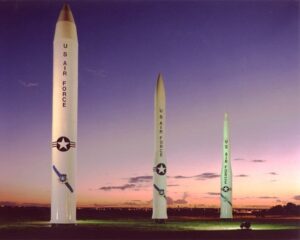GS3 – S&T

Context
The U.S. Air Force successfully test-launched its LGM-30G Minuteman III ICBM (Intercontinental Ballistic Missile), designed for long-range nuclear strike capabilities.
Minuteman III ICBM Overview:
- Originally deployed in the 1970s, the Minuteman III is set to be phased out and replaced by the LGM-35A Sentinel system.
- It serves as a reliable deterrent until the new system is fully operational.
- “LGM” refers to a silo-launched (L), ground-targeted (G), guided missile (M).
- Initially produced by Douglas Aircraft, later managed by McDonnell Douglas, and now maintained by Boeing.
Key Features:
- Operational Since: 1970s; it was the first U.S. missile to carry MIRVs (Multiple Independently targetable Reentry Vehicles), allowing one missile to hit multiple targets.
- Though designed for a 10-year lifespan, it has been extensively upgraded and will remain active until replaced in 2029.
- Specifications:
- Height: 18.2 m
- Diameter: 1.85 m
- Launch Weight: 34,000+ kg
- Speed: Up to Mach 23 (approx. 15,000 mph)
- Range: Around 13,000 km
- Payload: Originally housed 3 MIRV warheads, now limited to one under disarmament agreements.
- Deployment: Stored in reinforced underground silos operated by two-person crews with robust control systems.
- Propulsion: Three-stage solid-fuel engine.
- Redundancy: Airborne control teams provide a backup launch capability to ensure second-strike potential during conflict.
- Role in Nuclear Triad: It represents the land-based leg of the U.S. nuclear triad (alongside air and sea systems), ensuring credible deterrence.
- Reliability: Known for its nearly perfect test success rate, reinforcing its strategic value.




